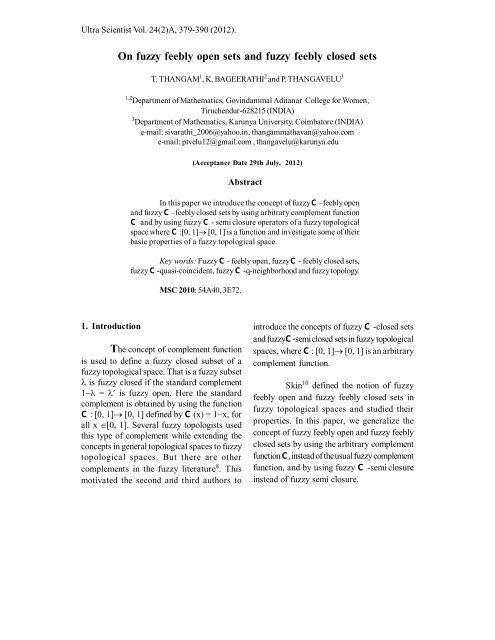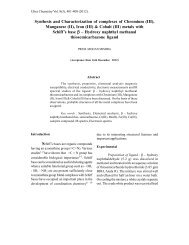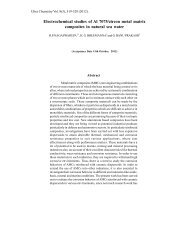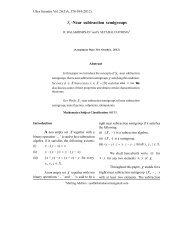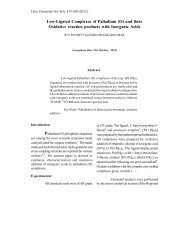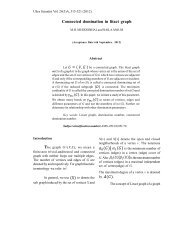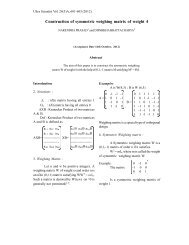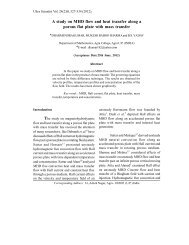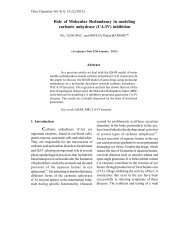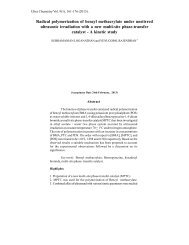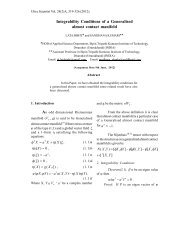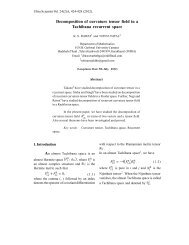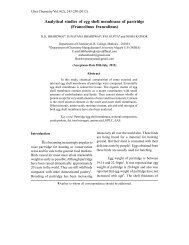On fuzzy feebly open sets and fuzzy feebly closed ... - Ultrascientist.org
On fuzzy feebly open sets and fuzzy feebly closed ... - Ultrascientist.org
On fuzzy feebly open sets and fuzzy feebly closed ... - Ultrascientist.org
Create successful ePaper yourself
Turn your PDF publications into a flip-book with our unique Google optimized e-Paper software.
Ultra Scientist Vol. 24(2)A, 379-390 (2012).<br />
<strong>On</strong> <strong>fuzzy</strong> <strong>feebly</strong> <strong>open</strong> <strong>sets</strong> <strong>and</strong> <strong>fuzzy</strong> <strong>feebly</strong> <strong>closed</strong> <strong>sets</strong><br />
T. THANGAM 1 , K. BAGEERATHI 2 <strong>and</strong> P. THANGAVELU 3<br />
1,2 Department of Mathematics, Govindammal Aditanar College for Women,<br />
Tiruchendur-628215 (INDIA)<br />
3 Department of Mathematics, Karunya University, Coimbatore (INDIA)<br />
e-mail: sivarathi_2006@yahoo.in, thangammathavan@yahoo.com<br />
e-mail: ptvelu12@gmail.com , thangavelu@karunya.edu<br />
(Acceptance Date 29th July, 2012)<br />
Abstract<br />
In this paper we introduce the concept of <strong>fuzzy</strong> C –<strong>feebly</strong> <strong>open</strong><br />
<strong>and</strong> <strong>fuzzy</strong> C –<strong>feebly</strong> <strong>closed</strong> <strong>sets</strong> by using arbitrary complement function<br />
C <strong>and</strong> by using <strong>fuzzy</strong> C - semi closure operators of a <strong>fuzzy</strong> topological<br />
space where C :[0, 1] [0, 1] is a function <strong>and</strong> investigate some of their<br />
basic properties of a <strong>fuzzy</strong> topological space.<br />
Key words: Fuzzy C - <strong>feebly</strong> <strong>open</strong>, <strong>fuzzy</strong> C - <strong>feebly</strong> <strong>closed</strong> <strong>sets</strong>,<br />
<strong>fuzzy</strong> C -quasi-coincident, <strong>fuzzy</strong> C -q-neighborhood <strong>and</strong> <strong>fuzzy</strong> topology.<br />
MSC 2010: 54A40, 3E72.<br />
1. Introduction<br />
The concept of complement function<br />
is used to define a <strong>fuzzy</strong> <strong>closed</strong> subset of a<br />
<strong>fuzzy</strong> topological space. That is a <strong>fuzzy</strong> subset<br />
is <strong>fuzzy</strong> <strong>closed</strong> if the st<strong>and</strong>ard complement<br />
1 = is <strong>fuzzy</strong> <strong>open</strong>. Here the st<strong>and</strong>ard<br />
complement is obtained by using the function<br />
C : [0, 1] [0, 1] defined by C (x) = 1x, for<br />
all x [0, 1]. Several <strong>fuzzy</strong> topologists used<br />
this type of complement while extending the<br />
concepts in general topological spaces to <strong>fuzzy</strong><br />
topological spaces. But there are other<br />
complements in the <strong>fuzzy</strong> literature 8 . This<br />
motivated the second <strong>and</strong> third authors to<br />
introduce the concepts of <strong>fuzzy</strong> C -<strong>closed</strong> <strong>sets</strong><br />
<strong>and</strong> <strong>fuzzy</strong>C-semi <strong>closed</strong> <strong>sets</strong> in <strong>fuzzy</strong> topological<br />
spaces, where C : [0, 1] [0, 1] is an arbitrary<br />
complement function.<br />
Skin 10 defined the notion of <strong>fuzzy</strong><br />
<strong>feebly</strong> <strong>open</strong> <strong>and</strong> <strong>fuzzy</strong> <strong>feebly</strong> <strong>closed</strong> <strong>sets</strong> in<br />
<strong>fuzzy</strong> topological spaces <strong>and</strong> studied their<br />
properties. In this paper, we generalize the<br />
concept of <strong>fuzzy</strong> <strong>feebly</strong> <strong>open</strong> <strong>and</strong> <strong>fuzzy</strong> <strong>feebly</strong><br />
<strong>closed</strong> <strong>sets</strong> by using the arbitrary complement<br />
function C, instead of the usual <strong>fuzzy</strong> complement<br />
function, <strong>and</strong> by using <strong>fuzzy</strong> C -semi closure<br />
instead of <strong>fuzzy</strong> semi closure.
380 T. Thangam, et al.<br />
For the basic concepts <strong>and</strong> notations,<br />
one can refer Chang 7 . The concepts that are<br />
needed in this paper are discussed in the<br />
second section. The section three is dealt with<br />
the concept <strong>fuzzy</strong> C -quasi-coincident. The<br />
concepts of <strong>fuzzy</strong>C - <strong>feebly</strong> <strong>open</strong> <strong>and</strong>C -<br />
<strong>feebly</strong> <strong>closed</strong> <strong>sets</strong> in <strong>fuzzy</strong> topological spaces<br />
<strong>and</strong> studied their properties in the fourth <strong>and</strong><br />
fifth section respectively.<br />
2. Preliminaries :<br />
Throughout this paper (X,) denotes<br />
a <strong>fuzzy</strong> topological space in the sense of<br />
Chang. Let C : [0, 1][0, 1] be a complement<br />
function. If is a <strong>fuzzy</strong> subset of (X,) then<br />
the complementC of a <strong>fuzzy</strong> subset is<br />
defined by C (x) = C ((x)) for all xX. A<br />
complement function C is said to satisfy<br />
(i) the boundary condition if C (0) = 1 <strong>and</strong> C<br />
(1) = 0,<br />
(ii) monotonic condition if x y C (x) C<br />
(y), for all x, y [0, 1],<br />
(iii) involutive condition if C (C (x)) = x, for<br />
all x [0, 1].<br />
The properties of <strong>fuzzy</strong> complement<br />
function C <strong>and</strong> C are given in Ge<strong>org</strong>e Klir 10<br />
<strong>and</strong> Bageerathi et al. 2 . The following lemma<br />
will be useful in sequel.<br />
Definition 2.1 [Definition 3.1, 2 ]<br />
Let (X,) be a <strong>fuzzy</strong> topological space<br />
<strong>and</strong> C be a complement function. Then a <strong>fuzzy</strong><br />
subset of X is <strong>fuzzy</strong> C -<strong>closed</strong> in (X,) if C<br />
is <strong>fuzzy</strong> <strong>open</strong> in (X,).<br />
Lemma 2.2 [Proposition 3.2, 2 ]<br />
Let (X, ) be a <strong>fuzzy</strong> topological space<br />
<strong>and</strong> C be a complement function that satisfies<br />
the involutive condition. Then a <strong>fuzzy</strong> subset<br />
of X is <strong>fuzzy</strong> <strong>open</strong> in (X,) if C is a <strong>fuzzy</strong><br />
C -<strong>closed</strong> subset of (X,).<br />
Definition 2.3 [Definition 4.1, 2 ]<br />
Let (X, ) be a <strong>fuzzy</strong> topological<br />
space. Then for a <strong>fuzzy</strong> subset of X, the<br />
<strong>fuzzy</strong>C -closure of is defined as the intersection<br />
of all <strong>fuzzy</strong> C -<strong>closed</strong> <strong>sets</strong> containing . The<br />
<strong>fuzzy</strong> C -closure of is denoted by ClC that<br />
is equal to {: , C }.<br />
Lemma 2.4 [Lemma 4.2, 2 ]<br />
If the complement function C satisfies<br />
the monotonic <strong>and</strong> involutive conditions, then<br />
for any <strong>fuzzy</strong> subset of X, (i) C (Int ) =<br />
Cl C<br />
(C ) <strong>and</strong> (ii) C (Cl C<br />
) = Int (C ).<br />
Definition 2.5 3<br />
A <strong>fuzzy</strong> topological space (X, ) is C<br />
-product related to another <strong>fuzzy</strong> topological<br />
space (Y, ) if for any <strong>fuzzy</strong> subset of X<br />
<strong>and</strong> of Y, whenever C <strong>and</strong> C <br />
implyC 1 1 C , where <br />
<strong>and</strong> , there exist 1 <strong>and</strong> 1 such<br />
that C 1 or C 1 <strong>and</strong> C 1 1 1 <br />
C 1 = C 1 1 C .<br />
Definition 2.6 11<br />
A <strong>fuzzy</strong> point with support xX <strong>and</strong><br />
the value r (0 < r 1) at xX will be denoted<br />
by x r <strong>and</strong> for <strong>fuzzy</strong> subset , x r if <strong>and</strong> only<br />
if (x) r.
<strong>On</strong> <strong>fuzzy</strong> <strong>feebly</strong> <strong>open</strong> <strong>sets</strong> <strong>and</strong> <strong>fuzzy</strong> <strong>feebly</strong> <strong>closed</strong> <strong>sets</strong>. 381<br />
Definition 2.7 11<br />
For any two <strong>fuzzy</strong> sub<strong>sets</strong> <strong>and</strong> ,<br />
we shall write q to mean that is quasi -<br />
coincident ( q- coincident, for short) with if<br />
there exists xX such that (x) + (x) > 1.<br />
Definition 2.8 :<br />
Let <strong>and</strong> be any two <strong>fuzzy</strong> sub<strong>sets</strong><br />
of a <strong>fuzzy</strong> topological space. Then is<br />
q -neighborhood with (q-nbd, for short) if<br />
there exists a <strong>fuzzy</strong> <strong>open</strong> set with q .<br />
Definition 2.9 :<br />
Let be a <strong>fuzzy</strong> subset of a <strong>fuzzy</strong><br />
topological space X then is said to be <strong>fuzzy</strong><br />
C - <strong>feebly</strong> <strong>open</strong> if there exists a <strong>fuzzy</strong> <strong>open</strong><br />
set in X such that sCl C <br />
.<br />
Definition 2.10<br />
Let be a <strong>fuzzy</strong> subset of a <strong>fuzzy</strong><br />
topological space X then is said to be <strong>fuzzy</strong><br />
<strong>feebly</strong> <strong>open</strong> if its complement is <strong>fuzzy</strong> <strong>feebly</strong><br />
<strong>closed</strong>.<br />
3. FuzzyC -quasi-coincident<br />
Definition 3.1<br />
A <strong>fuzzy</strong> point x r is said to be <strong>fuzzy</strong> C<br />
-quasi-coincident (q C<br />
-coincident, for short)<br />
with denoted by x r q C<br />
if r > C , where C<br />
: [0, 1] [0, 1] is a arbitrary complement<br />
function.<br />
Definition 3.2<br />
Let <strong>and</strong> be any two <strong>fuzzy</strong> sub<strong>sets</strong><br />
of a <strong>fuzzy</strong> topological spaces. Then is said<br />
to be <strong>fuzzy</strong> q C<br />
-coincident with ( q , for<br />
C<br />
short) iff there exists xX such that (x) > C<br />
(x) <strong>and</strong> is said to be a <strong>fuzzy</strong> C -quasi -<br />
neighborhood (q C<br />
- nbd, for short) of if there<br />
is a <strong>fuzzy</strong> <strong>open</strong> set with q C .<br />
Proposition 3.3<br />
Let (X, ) be a <strong>fuzzy</strong> topological space<br />
<strong>and</strong> C : [0, 1] [0, 1] be a complement<br />
function that satisfies the monotonic <strong>and</strong><br />
involutive conditions. Then for a <strong>fuzzy</strong> of a<br />
<strong>fuzzy</strong> topological space X, sCl C<br />
is the union<br />
of all <strong>fuzzy</strong> points x r such that every <strong>fuzzy</strong> C -<br />
semi <strong>open</strong> set with x r q C<br />
is <strong>fuzzy</strong> q C<br />
–<br />
coincident with .<br />
Proof :<br />
Let x r sCl C<br />
. Suppose there is a<br />
<strong>fuzzy</strong> C - semi <strong>open</strong> set such that x r q C<br />
<br />
<strong>and</strong> C<br />
. That implies that C , where C <br />
is <strong>fuzzy</strong> C - semi <strong>closed</strong>. Since C satisfies the<br />
monotonic <strong>and</strong> involutive conditions, by using<br />
Proposition 3.6 in 6 , C sCl C<br />
. By using<br />
Definition 2.6, x r C implies that x r sCl<br />
. This is a contradiction to our assumption.<br />
C<br />
Therefore for everyC - semi <strong>open</strong> with x r q C<br />
is q C<br />
-coincident with .<br />
Conversely, for everyC - semi <strong>open</strong><br />
with x r qC is q C<br />
-coincident with . Suppose<br />
x r sCl C<br />
. Then there is a <strong>fuzzy</strong> C - semi<br />
<strong>closed</strong> set G with x r G. Since C satisfies<br />
involutive condition, C G is <strong>fuzzy</strong> C - semi<br />
<strong>open</strong> set with x r qC (C G) <strong>and</strong> q C<br />
(C G). That<br />
is (x) >C (C G)=G. This is a contradiction to<br />
the assumption. Therefore x r sCl C<br />
.<br />
Proposition 3.4<br />
Let (X, ) be a <strong>fuzzy</strong> topological space<br />
<strong>and</strong> C : [0, 1] [0, 1] be a complement<br />
function that satisfies the monotonic <strong>and</strong>
382 T. Thangam, et al.<br />
involutive conditions. Let <strong>and</strong> be <strong>fuzzy</strong><br />
sub<strong>sets</strong> of a <strong>fuzzy</strong> topological space X. Then<br />
(i)<br />
If = 0 then q C<br />
<br />
(ii) x r q C<br />
for each x r q C<br />
<br />
(iii) q C<br />
C <br />
(iv) x r qC (V 0 ) there is 0 such<br />
that x r q C<br />
0<br />
Proof<br />
Let () (x) = 0. Then min {(x),<br />
(x)} = 0. This implies that (x) = 0 <strong>and</strong> (x)1<br />
(or) (x) = 0 <strong>and</strong> (x)1. Since C satisfies<br />
the monotonic <strong>and</strong> involutive conditions, C <br />
C (1)= (or)<br />
C C (1) = .That implies C . That<br />
shows C<br />
. This proves (i).<br />
Let . Then x r q C<br />
implies that<br />
C (x)
<strong>On</strong> <strong>fuzzy</strong> <strong>feebly</strong> <strong>open</strong> <strong>sets</strong> <strong>and</strong> <strong>fuzzy</strong> <strong>feebly</strong> <strong>closed</strong> <strong>sets</strong>. 383<br />
of a <strong>fuzzy</strong> topological space X with q C .<br />
Then q C ClC <strong>and</strong> ClC q C .<br />
Proof<br />
Let x r . Then x r if <strong>and</strong> only if<br />
(x) r. Since the complement functionC<br />
satisfies the monotonic condition, we get C<br />
(C (x)) r. By using Definition 3.1, x r q C C .<br />
This proves (a).<br />
Suppose q C . This implies that (x)<br />
C (x) for all x. Let x r (x) implies (x) <br />
r. Taking complement on both sides implies C<br />
(x) C r. Since C is <strong>fuzzy</strong> C -<strong>closed</strong>,<br />
Cl C C (x) C r. Since C satisfies the<br />
monotonic <strong>and</strong> involutive conditions, C (ClC<br />
(x)) r. This implies that x r C (ClC ).<br />
That shows (x) C (ClC (x)). From the<br />
above conclusion, q C ClC .<br />
Let x r ClC . Then by using<br />
Definition 2.11, ClC (x) r. Since q C ,<br />
we have ClC (x) C (x).This implies that<br />
C (x) r. It follows that ClC C , this<br />
shows Cl C<br />
q C .<br />
Proposition 3.7<br />
Let (X, ) be a <strong>fuzzy</strong> topological space<br />
<strong>and</strong> C be a complement function that satisfies<br />
the monotonic <strong>and</strong> involutive conditions. Let <br />
be a <strong>fuzzy</strong> subset of a <strong>fuzzy</strong> topological space<br />
(X, ). Then Int ClC sClC .<br />
Proof<br />
Let x r Int ClC . Then by using<br />
Definition 2.6, r Int ClC (x). This can be<br />
written as r ClC (x). This implies that<br />
x r sClC . This shows that x r sClC .<br />
Theorem 3.8<br />
Let (X, ) be a <strong>fuzzy</strong> topological space<br />
<strong>and</strong> C : [0, 1] [0, 1] be a complement<br />
function that satisfies monotonic <strong>and</strong> involutive<br />
conditions. If a <strong>fuzzy</strong> subset is <strong>fuzzy</strong> <strong>open</strong>,<br />
then Int ClC = sClC .<br />
Proof<br />
By using Proposition 3.7, it suffices<br />
to show that sClC Int ClC . Let x r Int<br />
ClC . Then x r qC C (Int ClC ). By using<br />
Lemma 2.4, x r qC (ClC Int C ). Since C<br />
satisfies the monotonic <strong>and</strong> involutive<br />
conditions, by using Proposition 3.5, ClC Int C<br />
= ClC Int ClC Int C . This can be written as<br />
ClC Int C ClC Int(ClC Int C ). By using<br />
Proposition 3.2 in 4 , ClC Int C is <strong>fuzzy</strong> C -<br />
semi <strong>open</strong>. By using Proposition 3.6, q C ClC<br />
Int C , that implies x r sClC . That shows<br />
sClC Int ClC . Therefore Int ClC =<br />
sClC .<br />
4. FuzzyC – <strong>feebly</strong> <strong>open</strong> <strong>sets</strong>.<br />
In this section we introduce the<br />
concept of C - <strong>feebly</strong> <strong>open</strong> <strong>sets</strong> in a <strong>fuzzy</strong><br />
topological space with respect to a complement<br />
function C : [0, 1] [0, 1].<br />
Definition 4.1<br />
Let be a <strong>fuzzy</strong> subset of a <strong>fuzzy</strong><br />
topological space X then is said to be <strong>fuzzy</strong><br />
C - <strong>feebly</strong> <strong>open</strong> if there exists a <strong>fuzzy</strong> <strong>open</strong><br />
set in X such that sClC .<br />
The class of all <strong>fuzzy</strong> <strong>feebly</strong> <strong>open</strong> <strong>sets</strong><br />
coincides with the class of all <strong>fuzzy</strong> C - <strong>feebly</strong><br />
<strong>open</strong> <strong>sets</strong> if the st<strong>and</strong>ard complement function<br />
coincides with the arbitrary complement<br />
function.
384 T. Thangam, et al.<br />
Proposition 4.2<br />
Let (X, ) be a <strong>fuzzy</strong> topological space<br />
<strong>and</strong> letC be a complement function that<br />
satisfies the monotonic <strong>and</strong> involutive conditions.<br />
Then a <strong>fuzzy</strong> subset of a <strong>fuzzy</strong> topological<br />
space (X,) is <strong>fuzzy</strong> C - <strong>feebly</strong> <strong>open</strong> if <strong>and</strong><br />
only if Int ClC Int .<br />
Proof.<br />
Let be a <strong>fuzzy</strong>C -<strong>feebly</strong> <strong>open</strong> set of<br />
a <strong>fuzzy</strong> topological space X. Then by using<br />
Definition 4.1, there is <strong>fuzzy</strong> <strong>open</strong> set such<br />
that sClC . By using Theorem 3.8, <br />
Int ClC , = Int Int , it follows that<br />
ClC ClC Int. This implies that Int ClC <br />
Int ClC Int. From the above Int ClC <br />
Int Cl C Int. That shows Int ClC Int.<br />
Conversely we assume that Int<br />
ClC Int. Now Int that implies Int Int<br />
ClC (Int). Since C satisfies the monotonic<br />
<strong>and</strong> involutive conditions, by using Proposition<br />
3.7, Int ClC Int sClC (Int). This implies<br />
that is <strong>fuzzy</strong>C -<strong>feebly</strong> <strong>open</strong> set in X.<br />
It is obvious that every <strong>fuzzy</strong> <strong>open</strong> set<br />
is <strong>fuzzy</strong> C -<strong>feebly</strong> <strong>open</strong> <strong>and</strong> every <strong>fuzzy</strong> C -<br />
<strong>feebly</strong> <strong>open</strong> set is <strong>fuzzy</strong> C - semi <strong>open</strong> but the<br />
separate converses may not be true as shown<br />
by the following example.<br />
Example 4.3<br />
Let X = {a, b} <strong>and</strong> = {0, {a. 3 , b. 8 },<br />
{a. 2 , b. 5 }, {a. 7 , b. 05 }, {a. 3 , b. 5 }, {a. 3 , b. 05 }, {a. 2 ,<br />
b. 05 }, {a. 7 , b. 8 }, {a. 7 , b. 5 }, 1}. Then (X, ) is a<br />
1<br />
x<br />
<strong>fuzzy</strong> topological space. Let C (x) = , 0<br />
1<br />
2x<br />
x 1. The family of all <strong>fuzzy</strong> C -<strong>closed</strong> <strong>sets</strong><br />
C () = {0,{a. 4375 , b. 077 }, {a. 57 , b. 25 }, {a. 125 , b. 86 },<br />
{a. 4375 , b. 25 }, {a. 4375 , b. 86 }, {a. 57 , b. 86 }, {a. 125 ,<br />
b. 077 }, {a. 125 , b. 25 }, 1}.<br />
Let ={a. 2 , b. 7 }. Then Int = {a. 2 , b. 5 },<br />
Cl C Int = {a. 4375 , b. 86 }. Int Cl C Int = {a. 3 ,<br />
b. 8 }. Thus we see that < Int Cl C Int . By<br />
using Proposition 4.2, is <strong>fuzzy</strong> C - <strong>feebly</strong><br />
<strong>open</strong> set but not <strong>fuzzy</strong> <strong>open</strong>.<br />
Let ={a. 4 , b. 5 }. Then Int = {a. 3 , b. 5 },<br />
Cl C Int = {a. 4375 , b. 86 }. Thus we see that <<br />
Cl C Int . By using Proposition 3.2 in 4 , is<br />
<strong>fuzzy</strong> C - semi <strong>open</strong>. But Int Cl C Int = {a. 3 ,<br />
b. 8 }. Here Int Cl C Int . By using Proposition<br />
4.2, is not <strong>fuzzy</strong> C - <strong>feebly</strong> <strong>open</strong>.<br />
The following example shows that the<br />
intersectionion of any two <strong>fuzzy</strong> C - <strong>feebly</strong><br />
<strong>open</strong> <strong>sets</strong> is not <strong>fuzzy</strong> C - <strong>feebly</strong> <strong>open</strong>.<br />
Example 4.4<br />
Let X = {a, b, c} <strong>and</strong> = {0, {a. 6 ,<br />
b. 3 }, {b. 4 , c. 7 }, {a. 2 , c. 5 }, {b. 3 }, {a. 6 , b. 4 , c. 7 },<br />
{a. 2 , b. 4 , c. 7 }, {c. 5 }, {a. 2 }, {a. 6 , b. 3 , c. 5 },<br />
{a. 2 , b. 3 }, {a. 2 , b. 3 , c. 5 }, {b. 3 , c. 5 }, 1}. Let<br />
1<br />
x<br />
C (x) = , 0 x 1, be a complement<br />
1<br />
2x<br />
function. The family of all <strong>fuzzy</strong> C-<strong>closed</strong> <strong>sets</strong><br />
C() = {0, {a. 18 , b. 44 , c 1 }, {a 1 , b. 33 , c. 125 }, {a. 57 ,<br />
b 1 , c. 25 }, {a 1 , b. 4375 , c 1 }, {a. 18 , b. 33 , c. 125 },<br />
{a. 57 , b. 33 , c. 125 }, {a 1 , b 1 , c. 25 }, {a. 57 , b 1 , c 1 },<br />
{a. 18 , b. 4375 , c. 25 }, {a. 57 , b. 4375 , c 1 }, {a. 57 , b. 4375 ,<br />
c. 25 }, {a 1 , b. 4375 , c. 25 }, 1}.<br />
Let = {a. 2 , b. 2 } <strong>and</strong> = {b. 4 , c. 5 } it<br />
can be computed that Int = {a. 2 },<br />
Cl C Int = {a. 57, b. 33 , c. 125 } <strong>and</strong> Int Cl C Int =
<strong>On</strong> <strong>fuzzy</strong> <strong>feebly</strong> <strong>open</strong> <strong>sets</strong> <strong>and</strong> <strong>fuzzy</strong> <strong>feebly</strong> <strong>closed</strong> <strong>sets</strong>. 385<br />
{a. 2 , b. 3 }. That shows Int Cl C Int.<br />
Also Int = {b. 3 , c. 5 }, Cl C Int = {a. 18 ,<br />
b. 4375 , c 1 } <strong>and</strong> Int Cl C Int = {b. 4 , c. 7 }. This<br />
shows that Int Cl C Int . Now =<br />
{b. 2 } it can be find that Int Cl C Int () = 0,<br />
we see that () Int Cl C Int ( ). From<br />
the above <strong>and</strong> by using Proposition 4.2, we<br />
see that is not <strong>fuzzy</strong> C - <strong>feebly</strong> <strong>open</strong><br />
even if <strong>and</strong> are <strong>fuzzy</strong> C - <strong>feebly</strong> <strong>open</strong>.<br />
B. Skin 9 established that any union of<br />
<strong>fuzzy</strong> <strong>feebly</strong> <strong>open</strong> <strong>sets</strong> is a <strong>fuzzy</strong> <strong>feebly</strong> <strong>open</strong><br />
set. Further the following example shows that<br />
the union of any two <strong>fuzzy</strong>C - <strong>feebly</strong> <strong>open</strong><br />
<strong>sets</strong> is not <strong>fuzzy</strong>C - <strong>feebly</strong> <strong>open</strong>.<br />
Example 4.5<br />
Let X= {a, b, c} <strong>and</strong> = {0, {a. 6 , b. 3 },<br />
{b. 4 , c. 7 }, {a. 2 , c. 5 }, {b. 3 }, {a. 6 , b. 4 , c. 7 },<br />
{a. 2 , b. 4 , c. 7 }, {c. 5 }, {a. 2 }, {a. 6 , b. 3 , c. 5 }, {a. 2 ,<br />
b. 3 }, {a. 2 , b. 3 , c. 5 }, {b. 3 , c. 5 }, 1}. Let C (x)<br />
2x<br />
= , 0 x 1, be a complement function.<br />
1 x<br />
The family of all <strong>fuzzy</strong> C -<strong>closed</strong> <strong>sets</strong><br />
C() = {0, {b. 57 , c. 75 }, {a. 75 , b. 46 },{a. 33 , c. 75 },<br />
{b. 46 },{a. 75 , b. 57 , c. 75 }, {a. 33 , b. 57 , c. 75 }, {c. 75 },<br />
{a. 33 }, {a. 75 , b. 46 , c. 75 }, {a. 33 , b. 46 }, {a. 33 , b. 46 ,<br />
c. 75 }, {b. 46 , c. 75 }, 1}. Let = {b. 3 , c. 7 } <strong>and</strong> <br />
= {a. 6 , b. 2 } it can be computed that Int =<br />
{b. 3 , c. 5 }, Cl C Int = {b. 46, c. 75 } <strong>and</strong> Int Cl C<br />
Int = {b. 4 , c. 7 }. That shows Int Cl C<br />
Int.<br />
Also Int = {a. 6 , b. 3 }, Cl C Int = {a. 75 ,<br />
b. 46 } <strong>and</strong> Int Cl C Int = {a. 6 , b. 3 }. This shows<br />
that Int Cl C Int . Now ={a. 6 , b. 3 , c. 7 }<br />
it can be find that Int Cl C Int () = {a. 6 ,<br />
b. 3 }, we see that () Int Cl C Int ( ).<br />
From the above <strong>and</strong> by using Proposition 4.2,<br />
we see that is not <strong>fuzzy</strong> C - <strong>feebly</strong><br />
<strong>open</strong> even if <strong>and</strong> are <strong>fuzzy</strong> C - <strong>feebly</strong><br />
<strong>open</strong>.<br />
Remark 4.6<br />
From Example 4.4, it is to observe that<br />
the intersection of any two <strong>fuzzy</strong> C - <strong>feebly</strong><br />
<strong>open</strong> <strong>sets</strong> is not <strong>fuzzy</strong> C - <strong>feebly</strong> <strong>open</strong>, even if<br />
the complement function C satisfies the<br />
monotonic <strong>and</strong> involutive conditions.<br />
Also, in view of the next proposition,<br />
if the complement functionC satisfies the<br />
monotonic <strong>and</strong> involutive conditions, then the<br />
arbitrary union of <strong>fuzzy</strong> C - <strong>feebly</strong> <strong>open</strong> <strong>sets</strong><br />
is <strong>fuzzy</strong> C - <strong>feebly</strong> <strong>open</strong>.<br />
Proposition 4.7<br />
Let (X, ) be a <strong>fuzzy</strong> topological space<br />
<strong>and</strong> C be a complement function that satisfies<br />
the monotonic <strong>and</strong> involutive conditions. Then<br />
the arbitrary union of <strong>fuzzy</strong> C -<strong>feebly</strong> <strong>open</strong><br />
<strong>sets</strong> is <strong>fuzzy</strong> C -<strong>feebly</strong> <strong>open</strong>.<br />
Proof.<br />
Let be a collection of <strong>fuzzy</strong> C -<br />
<strong>feebly</strong> <strong>open</strong> <strong>sets</strong> of a <strong>fuzzy</strong> topological space<br />
(X, ). Then by using Proposition 4.2, for each<br />
, Int Cl C Int . Thus<br />
<br />
<br />
<br />
Int<br />
Cl C Int . Since C satisfies the monotonic <strong>and</strong><br />
involutive conditions, by using Theorem 4.4 in 2 ,<br />
we have<br />
<br />
Int Cl C Int<br />
using Proposition 4.11,<br />
<strong>open</strong>.<br />
<br />
<br />
. Again by<br />
is <strong>fuzzy</strong> C -<strong>feebly</strong>
386 T. Thangam, et al.<br />
Theorem 4.8<br />
Let (X, ) <strong>and</strong> (Y, ) be any two <strong>fuzzy</strong><br />
topological spaces such that X is C -product<br />
related to Y. Then the product 1 2 of a <strong>fuzzy</strong><br />
C -<strong>feebly</strong> <strong>open</strong> set 1 of X <strong>and</strong> a <strong>fuzzy</strong> C -<br />
<strong>feebly</strong> <strong>open</strong> set 2 of Y is a <strong>fuzzy</strong> C -<strong>feebly</strong><br />
<strong>open</strong> set of the <strong>fuzzy</strong> product space X Y.<br />
Proof.<br />
Let 1 be a <strong>fuzzy</strong>C -<strong>feebly</strong> <strong>open</strong> subset<br />
of X <strong>and</strong> 2 be a <strong>fuzzy</strong> C -<strong>feebly</strong> <strong>open</strong> subset<br />
of Y. Then by using Proposition 4.2, we have<br />
1 Int Cl C Int 1 <strong>and</strong> 2 Int Cl CInt 2 . By<br />
using Theorem 2.19 in 3 , implies that 1 2 <br />
Int Cl C Int ( 1 2). By using Proposition 4.2,<br />
1 2 is a <strong>fuzzy</strong> C -<strong>feebly</strong> <strong>open</strong> set of the<br />
<strong>fuzzy</strong> product space X Y.<br />
5. FuzzyC –<strong>feebly</strong> <strong>closed</strong> <strong>sets</strong><br />
In this section we introduce the<br />
concept of C - <strong>feebly</strong> <strong>closed</strong> <strong>sets</strong> in a <strong>fuzzy</strong><br />
topological space with respect to a complement<br />
function C : [0, 1] [0, 1].<br />
Definition 5.1<br />
Let be a <strong>fuzzy</strong> subset of a <strong>fuzzy</strong><br />
topological space X then is said to be <strong>fuzzy</strong><br />
C - <strong>feebly</strong> <strong>closed</strong> if there exists a <strong>fuzzy</strong> C -<br />
<strong>closed</strong> set in X such that sInt C .<br />
The class of all <strong>fuzzy</strong> <strong>feebly</strong> <strong>closed</strong><br />
<strong>sets</strong> coincides with the class of all <strong>fuzzy</strong> C -<br />
<strong>feebly</strong> <strong>closed</strong> <strong>sets</strong> if the st<strong>and</strong>ard complement<br />
function coincides with the arbitrary<br />
complement function.<br />
Proposition 5.2<br />
Let (X, ) be a <strong>fuzzy</strong> topological space<br />
<strong>and</strong> let C be a complement function that<br />
satisfies the monotonic <strong>and</strong> involutive conditions.<br />
Then a <strong>fuzzy</strong> subset of a <strong>fuzzy</strong> topological<br />
space (X,) is <strong>fuzzy</strong> C- <strong>feebly</strong> <strong>closed</strong> if Cl C<br />
Int Cl C .<br />
Proof.<br />
Let be a <strong>fuzzy</strong> C -<strong>feebly</strong> <strong>closed</strong> set<br />
of a <strong>fuzzy</strong> topological space X. Then by using<br />
Definition 5.1, there is <strong>fuzzy</strong> C -<strong>closed</strong> set <br />
in X such that sInt C . Since C<br />
satisfies the monotonic <strong>and</strong> involutive<br />
conditions, by using Theorem 3.8, it follows<br />
that C (sCl C C ). By using Theorem<br />
3.5, Cl C Int . Since is <strong>fuzzy</strong> C -<br />
<strong>closed</strong>, = Cl C Cl C, it follows that Int <br />
Int Cl C . This implies that Cl C Int Cl C<br />
Int Cl C . From the above Cl C Int <br />
Cl C Int Cl C . That shows Cl C Int Cl C .<br />
Conversely we assume that Cl C<br />
Int Cl C . Now Int Cl C that implies Cl C<br />
C (Int Cl C C (Cl C )). Since C satisfies<br />
the monotonic <strong>and</strong> involutive conditions, by<br />
using Theorem 3.8, Cl C C (sCl C C<br />
(Cl C )) = sInt C (Cl C ). Therefore, by using<br />
Theorem 3.8, is <strong>fuzzy</strong> C -<strong>feebly</strong> <strong>closed</strong> set<br />
in X.<br />
The st<strong>and</strong>ard complement of <strong>fuzzy</strong><br />
<strong>feebly</strong> <strong>open</strong> set is <strong>fuzzy</strong> <strong>feebly</strong> <strong>closed</strong>. But the<br />
analogous result is not true for <strong>fuzzy</strong> C - <strong>feebly</strong><br />
-<strong>open</strong>. If the complement function C satisfies<br />
the monotonic <strong>and</strong> involutive conditions, then<br />
the arbitrary complement of <strong>fuzzy</strong> C - <strong>feebly</strong><br />
<strong>open</strong> is <strong>fuzzy</strong> C - <strong>feebly</strong> <strong>closed</strong> as shown in<br />
the next proposition.
<strong>On</strong> <strong>fuzzy</strong> <strong>feebly</strong> <strong>open</strong> <strong>sets</strong> <strong>and</strong> <strong>fuzzy</strong> <strong>feebly</strong> <strong>closed</strong> <strong>sets</strong>. 387<br />
Proposition 5.3<br />
Let be a <strong>fuzzy</strong> subset of a <strong>fuzzy</strong><br />
topological space (X,) <strong>and</strong> C be a complement<br />
function that satisfies the monotonic <strong>and</strong><br />
involutive conditions. Then is <strong>fuzzy</strong> C - <strong>feebly</strong><br />
<strong>closed</strong> if <strong>and</strong> only if C is <strong>fuzzy</strong> C - <strong>feebly</strong><br />
<strong>open</strong>.<br />
Proof.<br />
Let be <strong>fuzzy</strong> C - <strong>feebly</strong> <strong>closed</strong>. Then<br />
by using Proposition 5.2, Cl C Int Cl C .<br />
Taking complement on both sides, we get C<br />
(Cl C Int Cl C ) C . Since C satisfies the<br />
monotonic <strong>and</strong> involutive conditions, by using<br />
Lemma 2.4 (i) <strong>and</strong> (ii), we have Int Cl C Int C<br />
C . By using Proposition 4.2,C is <strong>fuzzy</strong><br />
C - <strong>feebly</strong> ope<br />
Conversely, C is <strong>fuzzy</strong> C - <strong>feebly</strong><br />
<strong>open</strong>. By using Proposition 4.2, C Int Cl C Int<br />
C . Taking complement on both sides, we<br />
getC (C ) C (Int Cl C Int C ). Since C<br />
satisfies the monotonic <strong>and</strong> involutive<br />
conditions, by using Lemma 2.4 (i) <strong>and</strong> (ii),<br />
we have Cl C Int Cl C . By using<br />
Proposition 5.2, is <strong>fuzzy</strong> C - <strong>feebly</strong> <strong>closed</strong>.<br />
The following example shows that if<br />
the conditions monotonic <strong>and</strong> involutive cannot<br />
be dropped from the hypothesis of Proposition<br />
5.3.<br />
Example 5.4<br />
Let X = {a, b} <strong>and</strong> = {0, {a. 3 , b. 8 },<br />
{a. 2 , b. 5 }, {a. 7 , b. 05 }, {a. 3 , b. 5 }, {a. 3 , b. 05 }, {a. 2 ,<br />
b. 05 }, {a. 7 , b. 8 }, {a. 7 , b. 5 }, 1}. Let C (x) = x ,<br />
0 x 1, be a complement function. We see<br />
that the complement function C does not<br />
satisfy the monotonic <strong>and</strong> involutive conditions.<br />
The family of all <strong>fuzzy</strong> C -<strong>closed</strong> <strong>sets</strong> is C ()<br />
= {0, {a. 548 , b. 894 }, {a. 447 , b. 707 }, {a. 837 , b. 223 },<br />
{a. 548 , b. 707 }, {a. 548 , b. 223 }, {a. 447 , b. 223 },<br />
{a. 837 , b. 894 }, {a. 837 , b. 707 }, 1}.<br />
Let = {a. 548 , b. 223 }. Then Cl C =<br />
{a. 548 , b. 223 }, Int Cl C ={a. 3 , b. 05 } <strong>and</strong> Cl C Int<br />
Cl C = {a. 447 , b. 223 }. This shows that Cl C Int<br />
Cl C . By using Definition 5.2, is <strong>fuzzy</strong><br />
C - <strong>feebly</strong> <strong>closed</strong>.<br />
But C = {a. 74 , b. 472 }. Then Int C <br />
= {a. 7 , b. 05 }, Cl C Int C = {a. 837, b. 223 } <strong>and</strong><br />
Int Cl C Int C = {a. 7 , b. 05 }. This shows that<br />
C Int Cl C Int C . By using Proposition<br />
4.2, C is not <strong>fuzzy</strong> C - <strong>feebly</strong> <strong>open</strong>.<br />
The following example shows that, if<br />
the complement function C does not satisfy<br />
the involutive condition then the conclusion of<br />
Proposition 5.3 is not true.<br />
Example 5.5<br />
Let X = {a, b} <strong>and</strong> = {0, {a. 3 , b. 8 },<br />
{a. 2 , b. 5<br />
}, {a. 7<br />
, b. 05<br />
}, {a. 3<br />
, b. 5<br />
}, {a. 3<br />
, b. 05<br />
}, {a. 2<br />
,<br />
b. 05<br />
}, {a. 7<br />
, b. 8<br />
}, {a. 7<br />
, b. 5<br />
}, 1}. Let C(x)<br />
3<br />
1<br />
x<br />
=<br />
3<br />
, 0 x 1, be a complement function.<br />
(1 x)<br />
This complement function C does not satisfy<br />
the involutive condition. The family of all <strong>fuzzy</strong><br />
C -<strong>closed</strong> <strong>sets</strong> C () = {0, {a. 443 , b. 084 }, {a. 574 ,<br />
b. 254 }, {a. 134 , b. 864 }, {a. 443 , b. 259 }, {a. 574 ,<br />
b. 864 }, {a. 134 , b. 084 }, {a. 134 , b. 084 },{a. 134 , b. 259 }, 1}.<br />
Let = {a. 443 , b. 259 } Then Cl C = {a. 443 ,<br />
b. 259 }, Int Cl C = {a. 3 , b. 05 } <strong>and</strong> Cl C Int Cl C<br />
= {a. 443 , b. 084 }. This shows that Cl C Int Cl C <br />
. By using Proposition 5.2, is <strong>fuzzy</strong>
388 T. Thangam, et al.<br />
C- <strong>feebly</strong> <strong>closed</strong>. ButC = {a. 304 , b. 492 }.<br />
Then Int C = {a. 3 , b. 05 }, Cl C Int C = {a. 443,<br />
b. 084 } <strong>and</strong> Int Cl C Int C = {a. 3 , b. 05 }. This<br />
shows that C Int Cl C Int C . By using<br />
Proposition 4.2, C is not <strong>fuzzy</strong> C- <strong>feebly</strong><br />
<strong>open</strong>.<br />
It is clear that every <strong>fuzzy</strong> C -<strong>closed</strong><br />
is a <strong>fuzzy</strong> C- <strong>feebly</strong> <strong>closed</strong> set. But the<br />
converse is not true as shown in the following<br />
example.<br />
Example 5.6<br />
Let X ={a, b, c} <strong>and</strong> = {0, {a. 6 , b. 3 },<br />
{b. 4 , c. 7 }, {a. 2 , c. 5 }, {b. 3 }, {a. 6 , b. 4 , c. 7 }, {a. 2 ,<br />
b. 4 , c. 7 }, {c. 5 }, {a. 2 }, {a. 6 , b. 3 , c. 5 }, {a. 2 , b. 3 },<br />
{a. 2 , b. 3 , c. 5 }, {b. 3 , c. 5 }, 1 }. Then (X, ) is a<br />
1<br />
x<br />
<strong>fuzzy</strong> topological space. Let C(x) = , 0<br />
1<br />
3x<br />
x 1, be a complement function. The family<br />
of all <strong>fuzzy</strong> C-<strong>closed</strong> <strong>sets</strong>C () = {0, {a 1 , b. 27 ,<br />
c. 097 }, {a. 143 , b. 368 , c 1 }, {a. 5 , b 1 , c. 2 }, {a 1 , b. 368 ,<br />
c 1 }, {a. 143 , b. 273 , c. 097 }, {a. 5 , b. 273 , c. 097 }, {a 1 ,<br />
b 1 , c. 2 }, {a. 5 , b 1 , c 1 }, {a. 143 , b. 368 , c. 2 }, {a. 5 ,<br />
b. 368 , c 1 }, {a. 5 , b. 368 , c. 2 }, {a 1 , b. 368 , c. 2 }, 1}.<br />
Let = {a. 5 , b. 5 , c. 2 }, it can be computed that<br />
ClC = {a. 5 , b 1 , c. 2 },<br />
Int ClC ={a. 2 , b. 3 , c. 5 } <strong>and</strong> ClC Int ClC ={a. 5 ,<br />
b. 368 , c. 2 }. This shows that ClC Int ClC .<br />
By using Proposition 5.2, is <strong>fuzzy</strong> C - <strong>feebly</strong><br />
<strong>closed</strong>. Also is not <strong>fuzzy</strong> C -<strong>closed</strong>.<br />
The following example show that the<br />
union of <strong>fuzzy</strong>C - <strong>feebly</strong> <strong>closed</strong> <strong>sets</strong> is not <strong>fuzzy</strong><br />
C - <strong>feebly</strong> <strong>closed</strong>.<br />
Example 5.7<br />
From the above Example 5.6, let X =<br />
{a, b, c} <strong>and</strong> = {0, {a. 6 , b. 3 }, {b. 4 , c. 7 },<br />
{a. 2 , c. 5 }, {b. 3 }, {a. 6 , b. 4 , c. 7 }, {a. 2 , b. 4 , c. 7 },<br />
{c. 5 }, {a. 2 }, {a. 6 , b. 3 , c. 5 }, {a. 2 , b. 3 }, {a. 2 , b. 3 ,<br />
c. 5 }, {b. 3 , c. 5 }, 1}. Let = {a. 5 , b. 5 , c. 2 } <strong>and</strong> <br />
= {a. 5 , b. 368 , c 1 }. Then it can be computed that<br />
ClC = {a. 5 , b 1 , c. 2 }, Int ClC = {a. 2 , b. 3 , c. 5 }<br />
<strong>and</strong> ClC Int ClC = {a. 5 , b. 368 , c. 2 }. That<br />
shows ClC Int ClC .In the same way, ClC<br />
= {a. 5 , b. 368 , c 1 }, Int ClC = {a. 2 , b. 3 , c. 5 }<br />
<strong>and</strong> ClC Int ClC = { a. 5 , b. 368 , c 1 }. This shows<br />
that ClC Int ClC . By using Proposition 5.2,<br />
<strong>and</strong> are <strong>fuzzy</strong> C - <strong>feebly</strong> -<strong>closed</strong>. Now let<br />
={a. 5 , b. 5 , c 1 }. Then ClC()={a. 5 , b 1 , c 1 },<br />
Int ClC() = {a. 2 , b. 4 , c. 7 } <strong>and</strong> ClC Int ClC<br />
()={a. 5 , b 1 , c 1 }. This shows that ClC Int<br />
ClC () . By using Proposition 5.2, <br />
is not <strong>fuzzy</strong> C - <strong>feebly</strong> <strong>closed</strong>.<br />
Furthermore, the following example<br />
shows that the intersection of <strong>fuzzy</strong> C- <strong>feebly</strong><br />
<strong>closed</strong> <strong>sets</strong> is not <strong>fuzzy</strong> C- <strong>feebly</strong> <strong>closed</strong>.<br />
Example 5.8<br />
Let X = {a, b} <strong>and</strong> = {0, {a. 3 , b. 8 },<br />
{a. 2 , b. 5 }, {a. 7 , b. 05 }, {a. 3 , b. 5 }, {a. 3 , b. 05 }, {a. 2 ,<br />
b. 05 }, {a. 7 , b. 8 },{a. 7 , b. 5 }, 1}. Let C (x) =<br />
2x<br />
, 0 x 1 be the complement function.<br />
1 x<br />
Then the family of all <strong>fuzzy</strong> C -<strong>closed</strong> <strong>sets</strong><br />
C () = {0, {a. 462 , b. 889 }, {a. 33 , b. 667 }, {a. 824 ,<br />
b. 095 }, {a. 462 ,b. 667 }, {a. 462 , b. 095 },{a. 33 , b. 095 },<br />
{a. 824 , b. 889 },{a. 824 , b. 667 },1}. Let = {a. 4 ,<br />
b. 667 } <strong>and</strong> = {a. 5 , b. 3 }. Then it can be<br />
computed that Cl C = {a.462 , b. 667 }, Int Cl C
<strong>On</strong> <strong>fuzzy</strong> <strong>feebly</strong> <strong>open</strong> <strong>sets</strong> <strong>and</strong> <strong>fuzzy</strong> <strong>feebly</strong> <strong>closed</strong> <strong>sets</strong>. 389<br />
= {a. 3 , b. 5 } <strong>and</strong> Cl C Int ClC = {a.33 , b. 667 }.<br />
That shows Cl C Int ClC . In the same<br />
way, Cl C = {a.824 , b. 667 }, Int Cl C = {a.7 ,<br />
b. 5 } <strong>and</strong> Cl C Int ClC = { a.824 , b. 667 }. This<br />
shows that Cl C Int Cl C . By using<br />
Proposition 3.19, <strong>and</strong> is <strong>fuzzy</strong> C - <strong>feebly</strong><br />
<strong>closed</strong>.<br />
Now = {a. 4 , b. 3 }. Then Cl C<br />
() = {a. 462 , b. 667 }, Int Cl C ()={a.3 , b. 5 }<br />
<strong>and</strong> Cl C Int ClC () = {a.462 , b. 667 }. This<br />
shows that Cl C Int ClC ( ) . By using<br />
Proposition 5.2, is not <strong>fuzzy</strong>C- <strong>feebly</strong><br />
<strong>closed</strong>.<br />
Remark 5.9<br />
Further, the Example 3.24 shows that<br />
the union of any two <strong>fuzzy</strong> C - <strong>feebly</strong> <strong>closed</strong><br />
<strong>sets</strong> need not be <strong>fuzzy</strong> C - <strong>feebly</strong> <strong>closed</strong>, even<br />
though the complement function satisfies the<br />
monotonic <strong>and</strong> involutive conditions.<br />
If the complement functions C satisfies<br />
the monotonic <strong>and</strong> involutive conditions, then<br />
arbitrary intersection of <strong>fuzzy</strong> C - <strong>feebly</strong> <strong>closed</strong><br />
<strong>sets</strong> is <strong>fuzzy</strong> C - <strong>feebly</strong> <strong>closed</strong> as shown in the<br />
following proposition.<br />
Proposition 5.10<br />
Let (X, ) be a <strong>fuzzy</strong> topological space<br />
<strong>and</strong> C be a complement function that satisfies<br />
the monotonic <strong>and</strong> involutive conditions. Then<br />
the arbitrary intersection of <strong>fuzzy</strong>C - <strong>feebly</strong><br />
<strong>closed</strong> <strong>sets</strong> is <strong>fuzzy</strong> C - <strong>feebly</strong> <strong>closed</strong>.<br />
Proof.<br />
Let be a collection of <strong>fuzzy</strong> C- <strong>feebly</strong><br />
<strong>closed</strong> <strong>sets</strong> of a <strong>fuzzy</strong> topological space (X,<br />
). Then by using Proposition 5.2, C be a<br />
collection of <strong>fuzzy</strong> C- <strong>feebly</strong> <strong>open</strong> <strong>sets</strong>. By<br />
using Proposition 4.2, for each , C Int<br />
Cl C Int C . Also by Proposition 4.7, we have<br />
arbitrary union of <strong>fuzzy</strong> C - <strong>feebly</strong> <strong>open</strong> <strong>sets</strong><br />
are <strong>fuzzy</strong> C - <strong>feebly</strong> <strong>open</strong>. Thus we have<br />
C Int Cl C Int C . Since C satisfies the<br />
monotonic <strong>and</strong> involutive conditions, by using<br />
Lemma 2.9 in 2 , we have C () Int Cl C Int<br />
C (). This shows that, C () is <strong>fuzzy</strong><br />
C- <strong>feebly</strong> <strong>open</strong>. Then by using Proposition 5.2,<br />
we have is <strong>fuzzy</strong> C - <strong>feebly</strong> <strong>closed</strong>.<br />
References<br />
1. K.K. Azad, <strong>On</strong> <strong>fuzzy</strong> semi-continuity,<br />
<strong>fuzzy</strong> almost continuity <strong>and</strong> <strong>fuzzy</strong> weakly<br />
continuity, J. Math. Anal. Appl. 82(1),<br />
14-32 (1981).<br />
2. K. Bageerathi, G. Sutha, P. Thangavelu,<br />
A generalization of <strong>fuzzy</strong> <strong>closed</strong> <strong>sets</strong>,<br />
International Journal of <strong>fuzzy</strong> systems<br />
<strong>and</strong> rough systems, 4(1), 1-5 (2011).<br />
3. K. Bageerathi, P. Thangavelu, A generalization<br />
of <strong>fuzzy</strong> Boundary, International<br />
Journal of Mathematical Archive – 1(3),<br />
73-80 (2010).<br />
4. K. Bageerathi, P. Thangavelu, <strong>On</strong> generalization<br />
of nearly <strong>fuzzy</strong> <strong>open</strong> <strong>sets</strong>, Proceedings<br />
of the International Seminar <strong>On</strong> New<br />
Trends in Applications of Mathematics<br />
(ISNTAM 2011) Bharata Mata College,<br />
Kerala, Jan 31, Feb 1-2(2011). (To appear).<br />
5. K. Bageerathi, P. Thangavelu, <strong>On</strong> nearly<br />
<strong>fuzzy</strong> C-<strong>closed</strong> <strong>sets</strong> in <strong>fuzzy</strong> topological<br />
spaces, Advances in Theoretical Mathematics<br />
<strong>and</strong> Applied Sciences –6(5), 617-<br />
633 (2011).
390 Ultra Scientist Vol.24(2)A, (2012).<br />
6. K. Bageerathi, P. Thangavelu, A generalization<br />
of <strong>fuzzy</strong> semi-boundary, International<br />
Journal of Ultra Scientist of Physical<br />
Sciences, 23(3)A, Dec, 855-868 (2011).<br />
7. C. L. Chang, Fuzzy topological space, J.<br />
Math. Anal. Appl. 24, 182-190 (1968).<br />
8. Ge<strong>org</strong>e J. Klir <strong>and</strong> Bo Yuan, Fuzzy Sets<br />
<strong>and</strong> Fuzzy Logic Theory <strong>and</strong> Applications,<br />
Prentice – Hall, Inc, (2005).<br />
9. K. Katsaras <strong>and</strong> D.B. Liu, Fuzzy vector<br />
spaces <strong>and</strong> <strong>fuzzy</strong> topological vector spaces,<br />
J. Math. Anal. Appl. 8 (3), 459-470<br />
(1978).<br />
10. B. Sikn, <strong>On</strong> <strong>fuzzy</strong> FC-Compactness,<br />
Comm. Korean Math. Soc. 13, 137-150<br />
(1998).


